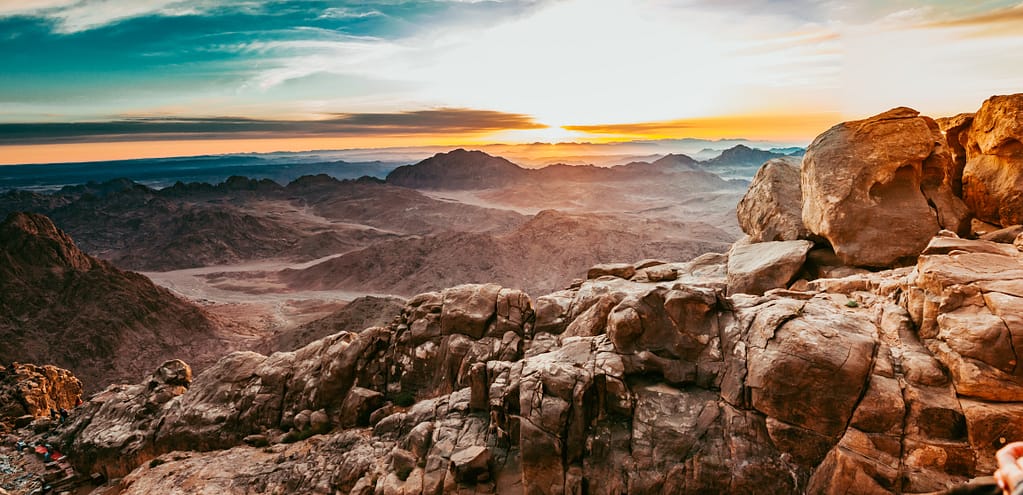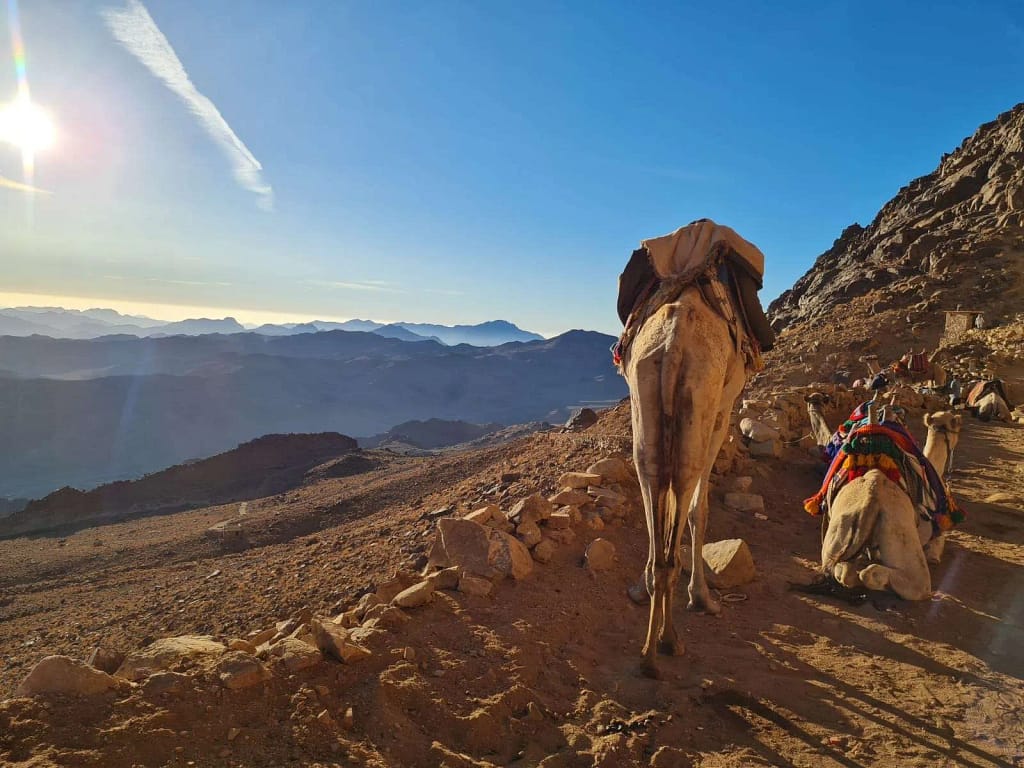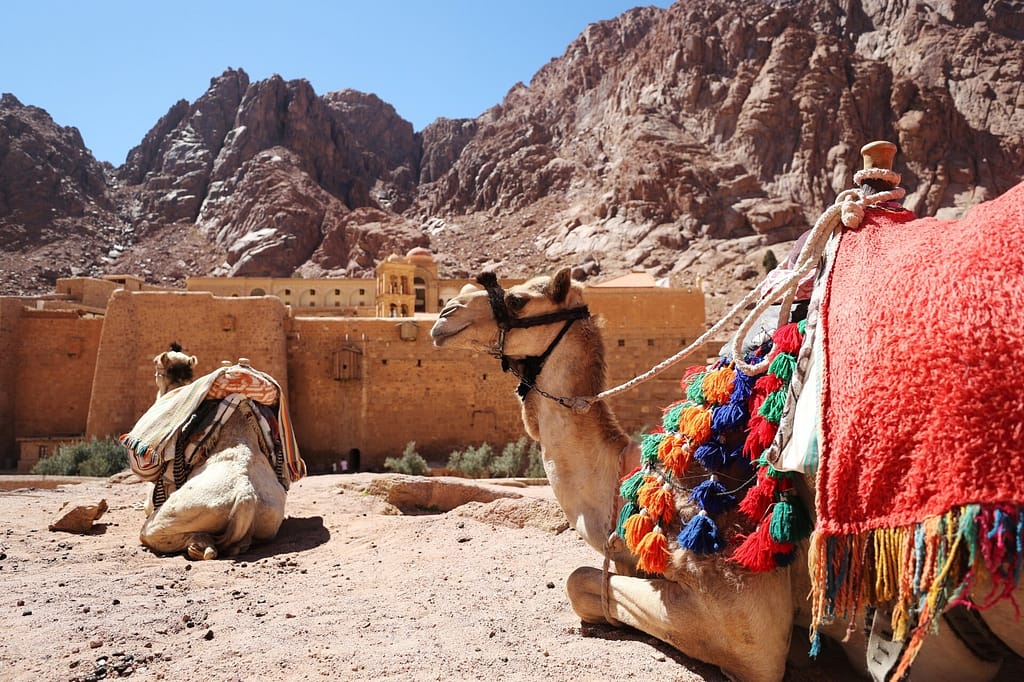Travel to Mount Sinai is a journey that beckons adventurers, pilgrims, and nature enthusiasts alike. Nestled in the rugged and mystical landscape of the Sinai Peninsula in Egypt, Mount Sinai, also known as Jebel Musa, has captivated the human spirit for centuries. The allure of Mount Sinai travel lies not only in its awe-inspiring natural beauty but also in its profound historical and religious significance. As the reputed site where Moses received the Ten Commandments, this sacred peak attracts countless visitors seeking spiritual enlightenment. Moreover, the rugged terrain and serene surroundings make it a hiking destination of choice for those in search of adventure and breathtaking vistas. Join us on and get your Mount Sinai tour today.
Travel to Mount Sinai Today
Check out Mount Sinai Tours Today!
About Mount Sinai
Mount Sinai rises approximately 2,200 meters above sea level, making it the highest peak in the region. Its rugged terrain and barren landscapes contribute to its unique terrain. The mountain is primarily made of granite and is surrounded by a vast desert expanse. (World History Encyclopedia: Mount Sinai)
Apart from its spiritual significance, Mount Sinai offers a unique adventure for those drawn to its rugged terrain and stark, natural beauty. The journey to the summit, while spiritually enriching, is also a physical challenge that promises a rewarding experience for hikers and nature enthusiasts.

Mount Sinai in Monotheism
Mount Sinai holds a significant place in biblical history. The mountain holds significance in the story of the Prophet Musa (Moses). The prophet received divine revelations and guidance on this mountain. In the Book of Exodus, it was on this mountain that Moses received the Ten Commandments from God, solidifying the foundation of the law and ethics. The mountain is often associated with the presence of the divine and is considered a sacred site for prayer and contemplation. Mount Sinai holds deep spiritual importance for several major world religions, making it a prominent pilgrimage site. Some key aspects of its religious significance include:
Christianity: Mount Sinai is the place where Moses received the Ten Commandments from God, as described in the Bible. The Saint Catherine’s Monastery at the mountain’s base is a significant Christian pilgrimage site, dating back over 1,400 years. Pilgrims often ascend the mountain to visit the small chapel at its summit.
Islam: In Islam, Mount Sinai is known as Jebel Musa. While it’s not as prominent as Mecca or Medina, it holds significance as a place where prophets received revelations from God. Muslims also make the journey to the summit, where a small mosque is situated.
Judaism: As mentioned earlier, Mount Sinai is a crucial site in Judaism due to its association with the receipt of the Ten Commandments. Jewish visitors often trek to the summit to reflect on this significant moment in their faith’s history.
The Climb: Ascending Mount Sinai
Climbing Mount Sinai is a popular activity for travelers seeking adventure and spiritual connection. The journey to the summit typically begins at Saint Catherine’s Monastery.
Timing: The most popular time to climb Mount Sinai is in the evening, aiming to reach the summit for sunrise. This offers a spectacular view of the sunrise over the rugged landscape. Starting around 2-3 a.m. is common, and the hike usually takes around 2-3 hours.
Trail Options: There are several trails leading to the summit, with the Camel Path and the Camel Walk being the most common. The Camel Path allows you to ride a camel part of the way, while the Camel Walk is a more challenging route reserved for hikers.
Guide: While it’s possible to hike independently, having a local guide can be advantageous for navigation and safety. Guides are well-versed in the trail and can provide cultural and historical insights.
Dress Appropriately: Be sure to dress warmly, as the temperature can drop significantly during the early morning hours. Sturdy shoes are also essential.
Water and Snacks: Carry enough water and snacks for the journey. Vendors along the trail offer refreshments, but prices can be higher.

Experiencing the Sunrise
The highlight of ascending Mount Sinai is undoubtedly witnessing the sunrise from the summit. The view is awe-inspiring, as the sun bathes the surrounding mountains in golden light, creating a stunning visual spectacle. The experience is often described as spiritual and serene, making the early morning hike well worth the effort.
Saint Catherine’s Monastery: A Cultural Gem
Saint Catherine’s Monastery, officially known as the Sacred Monastery of the God-Trodden Mount Sinai, is one of the oldest Christian monasteries in the world. Some notable aspects of this historical and cultural site include:
The Burning Bush: According to tradition, the chapel within the monastery contains the burning bush from which God spoke to Moses. The chapel is open to visitors.
The Library: Saint Catherine’s Monastery is home to one of the most significant collections of early Christian manuscripts, including some of the oldest known copies of the Bible.
Icon Gallery: The monastery also houses a collection of religious icons that have been carefully preserved over the centuries.
The Monastery’s Bell: Visitors are often intrigued by the story of the monastery’s hanging bell, which, according to legend, will ring out to announce the last judgment.
Trekking in the Surrounding Area
While the climb to the summit of Mount Sinai is the primary attraction, the surrounding area offers opportunities for more trekking and exploration:
Mount Catherine: Often overlooked, Mount Catherine is the highest peak in the Sinai Peninsula. Hiking to its summit provides an even more commanding view of the region.
Camel Rides: For a less strenuous adventure, consider exploring the vicinity on a camel ride. You can rent a camel from local guides and explore the desert landscapes at a more leisurely pace.
The Steps of Repentance: Halfway up the mountain, you’ll encounter the “Steps of Repentance” or “Seven Thousand Steps.” The name alone evokes a sense of spiritual reflection. Pilgrims often use this time to pause and contemplate their own journey, much like the biblical Moses did when he received the commandments. The Steps of Repentance are a challenging climb, and ascending them can be seen as an act of penance or purification.
Guided Tours: Guided tours in the Sinai Peninsula are available for travelers interested in exploring more of the area, including Bedouin camps and desert safaris.

Bedouin Hospitality: An Authentic Experience
The Bedouin people have inhabited the Sinai Peninsula for centuries, and their culture and traditions remain an integral part of the region. Travelers have the opportunity to experience Bedouin hospitality through various means:
Bedouin Camps: Spend a night or more in a traditional Bedouin camp in the desert. These experiences often include Bedouin meals, stargazing, and the chance to learn about their customs.
Local Cuisine: Savor traditional Bedouin cuisine, which typically includes dishes like grilled meats, flatbreads, and sweet teas. Sharing a meal with the Bedouin is an excellent way to connect with the local culture.
Mount Sinai Travel
My Personal Experience
At the early hour of 2 am, I woke up and started my ascent in the stary night at Mount Sinai. The desert air was cold, but I was ready to begin. As I ventured higher, I encountered tea stops. Bedouin locals had established rest stops, offering hospitality and warm tea. After drinking tea, I continued on my journey.
Finally, after reaching the summit, I took a rest in a tent, graciously provided by the inhabitants. Cuddled in a warm blanket, I felt a sense of relief. I then embarked to the Mosque situated atop of the mountain to pray Fajr.
Emerging from the Mosque, I was greeted by a breathtaking beauty. The sun ascended, casting vibrant beams of light across the sky. I stood in amaze as I witnessed nature’s display unfold. The vast desert landscape invoked a sense of awe within me. For forty-five precious minutes, I embraced the splendor. I contemplated the profound symbolism and spiritual significance of the moment. With a heart brimming with gratitude, I bid farewell to the mountaintop and embarked on my descent.
Learn Arabic with Rocket Languages before Traveling
Rocket Languages provides the best practices and methods to learn a language. Every course offers over 100 hours of high quality tuition. As a result, over a million people choose Rocket Languages to learn a language.
START LEARNING NOW!!✓ Learn more than 10 languages fluently
✓Based on the best scientific and practical methods to learn a language.
Things to Know while Visiting Mount Sinai
Visiting Mount Sinai, a mountain in the Sinai Peninsula of Egypt, is a journey of historical, cultural, and
spiritual significance. Here are seven important things to consider when planning travel to mount sinai:
Significance
Mount Sinai is revered as a holy site in Judaism, Christianity, and Islam. It is traditionally considered to
be the mountain where Moses received the Ten Commandments.
Preparation for the Climb
The climb is moderately challenging. There are two main routes to the summit – the Camel Path (or
Siket Sayidna Musa), which is longer but less steep, and the Steps of Repentance, a path with nearly
3,000 steps carved into the rock by a monk. Be sure to wear comfortable walking shoes and carry water.
Weather
The weather can be extreme, with cold nights and hot days when you choose to travel to Mount Sinai.
The summit can be quite cold and windy, especially before sunrise. Dressing in layers is advisable, and
you may want to bring a warm jacket for the early morning or evening.
Timing Your Visit
Many visitors climb at night to reach the summit in time for sunrise, which can be a stunning sight. If
you’re not keen on climbing in the dark or don’t want to deal with the overnight chill, you can start early
in the morning.
Accommodation
Accommodations are available at the mountain’s base, including guest houses and basic hotels. Booking
in advance is advisable, especially during peak pilgrimage seasons.
Cultural Sensitivity
As a place of worship and pilgrimage, visitors are expected to dress modestly and behave respectfully.
This includes speaking softly and avoiding loud noises, as well as adhering to local customs and
traditions.
Access and Regulations
The area can be subject to restrictions and regulations by the Egyptian government. It is important to
check the current political situation, travel advisories, and any rules set by the local authorities before
planning your trip. Hiring a local guide is often recommended to navigate the region safely and
responsibly.
Climbing the Mountain
Mount Sinai stands over 2,000 meters (over 6,500 feet) tall, and climbing to the top can be quite
strenuous. There are two main paths: the gentler, longer Camel Path and the more direct but steeper
Steps of Repentance. Most people take 2 to 3 hours to climb the mountain on foot. Ensure you are in
good physical condition when you choose Mount Sinai travel, wear appropriate footwear, carry enough
water, and bring layers for the changing temperatures.
Timing for the Ascent
Climbing Mount Sinai for the sunrise means starting the trek in the very early morning hours. The
sunrise views over the mountains and desert are spectacular and often a highlight for many travelers.
However, if an overnight climb doesn’t appeal to you, a daytime ascent or being there for sunset are
also worthwhile experiences. Be sure to check the time for sunrise or sunset before you choose mount
sinai travel, as these can vary throughout the year.

Best Time to Visit Mount Sinai
The best time to travel to Mount Sinai generally depends on what you’re looking for in your experience,
but most travelers find that certain times of the year offer more favorable conditions:
Weather Considerations
Spring (April to June) and autumn (September to November) are often
considered the best times to visit Mount Sinai. The temperatures are milder during these
months, making the climb more comfortable. Summers can be scorchingly hot, especially during
midday, and winters can be quite cold, especially at night and in the early morning.
Crowds
The mountain can become quite crowded during major religious holidays and on
weekends. If you prefer a quieter experience, plan your climb on a weekday and avoid religious
holidays when pilgrimages may increase the number of visitors.
Sunrise Summit
Many visitors climb Mount Sinai overnight to reach the summit for the sunrise,
which is a breathtaking view. The weather is typically clearer during the spring and autumn,
which can lead to better sunrise views.
Festivals and Events
Check the local calendar for festivals or religious events. These can be both
an attraction and a deterrent: an attraction, as they offer a deeper insight into the local culture
and religion, and a deterrent because they can lead to overcrowding.
Ramadan
During the Islamic month of Ramadan, the opening hours of many services may
change, and you may find that facilities around Mount Sinai are affected. It’s important to
consider this if your visit coincides with Ramadan.
Off-Peak Times
If you’re not fixated on the idea of a sunrise climb, consider starting your ascent
early in the morning to witness the sunrise from a lower elevation or to enjoy the view from the
summit during the day. This can often mean a less crowded path when you consider Mount
Sinai travel.
It’s always a good idea to check the current weather forecasts and local conditions before planning your
Mount Sinai travel. Additionally, for the most current advice and updates, consider contacting local tour
operators or tourist information centers in Egypt.

Conclusion
Traveling to Mount Sinai offers a remarkable experience, both for its religious and natural attractions. Many travelers embark on a challenging trek to reach the summit in order to witness the stunning sunrise or sunset, which casts a golden glow over the surrounding desert. The climb to the top can be physically demanding, but it is a rewarding endeavor that allows visitors to appreciate the panoramic views and feel a sense of spiritual connection.
If you liked this article, please subscribe for monthly updates on all our new posts.
Or follow us on Pinterest.
Q.: What is the significance of Mount Sinai in religious history?Mount Sinai, also known as Jebel Musa, holds profound religious importance, particularly in Christianity, Islam, and Judaism. It is widely recognized as the place where Moses received the Ten Commandments from God, making it a sacred pilgrimage site for followers of these faiths.
Q.: Why is climbing Mount Sinai a popular activity?Climbing Mount Sinai is a popular activity due to its dual appeal as both a spiritually enriching journey and a physically challenging adventure. The trek to the summit offers breathtaking views and a connection to the historical and religious significance of the mountain.
Q.: What are the best times to climb Mount Sinai?The most popular time to climb Mount Sinai is in the evening, with the aim of reaching the summit for sunrise.Starting the ascent around 2-3 a.m. is common, providing a spectacular view of the sunrise over the rugged landscape.
Q.: Are there different trail options for climbing Mount Sinai?Yes, there are several trails leading to the summit, with the Camel Path and the Camel Walk being the most common. The Camel Path allows for camel assistance, while the Camel Walk is a more challenging route reserved for hikers.
Q.: What cultural and historical sites are associated with Mount Sinai?Saint Catherine’s Monastery, located at the mountain’s base, is a significant cultural and historical site. It houses the Burning Bush chapel, a library with early Christian manuscripts, an icon gallery, and a bell with a legendary story. The surrounding area also offers attractions like Mount Catherine and the Steps of Repentance.
